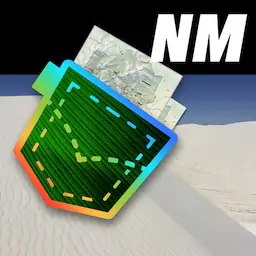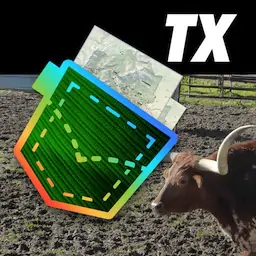"White dune landscape, White Sands National Monument, 2016." by U.S. National Park Service , public domain
A Desert GalápagosWhite Sands |
Field Notes about A Desert Galapagos at White Sands National Park (NP) in New Mexico, by William Conrod, with Erica Bree Rosenblum. Published by the National Park Service (NPS).
Field Notes
A Desert Galápagos
By William Conrod, with Erica Bree Rosenblum
Some animals inhabiting the white gypsum
sand dunes of New Mexico shed their colors
in less than 7,000 years.
A
flash of movement caught my eye.
If the lizard had stayed still, I
might have stepped on it: its
color perfectly matched the dazzling
expanse of white sand. Good thing,
I thought, that rattlesnakes here in
south-central New Mexico aren’t
white too. Three different species of
white lizards can be spotted on the
dunes from May through September.
That is, if you’re looking for them.
I was standing on the world’s
largest gypsum dune field, at White
Sands National Monument, where I
have worked as a biologist and land
manager for nine years. Looking up
from my feet, I gazed out across a
sea of snow-white dunes to a rugged
skyline of bare limestone mountains.
The dune field covers an area of 275
square miles, about half of which
is open to the public and managed
by the National Park Service. The
other half is military land, shared by
a missile range and Holloman Air
16
n at u r a l h i s to ry
May 2008
Force Base. Recent findings indicate the dunes formed within the
past 7,000 years—a geological blink
of the eye. And that gives a useful
time frame for the rapid evolution of
lizards, like the one I saw skittering
across the sand.
Other creatures that, like the
lizards, are small and easily preyed
upon, have also tended toward lighter colors. With a permanent change
of coloration, they can improve
concealment on the gypsum dunes
and thereby improve their chances
of survival, as well as their chances
of producing future generations that
will inherit the advantage. You can
see this on a short stroll from a park
road in New Mexico
G
ypsum is the stuff of plaster and
drywall: a common mineral also
known as hydrated calcium sulfate.
Why then have some 8 billion tons
of it collected in a series of dunes up
to forty feet tall? The “white sand”
of White Sands had its distant origin
when marine deposits were left by
an evaporating shallow sea in the
Permian period, 250 million years
ago. Some of those deposits were
uplifted about 10 million years ago
into mountain ranges that ring an
area known today as the Tularosa
Basin. Water leached gypsum out of
those mountains and carried the dissolved mineral down into the Basin,
where a large saline lake formed
during the cooler and wetter times
of the Pleistocene, within the past 2
million years.
The environment ultimately
changed about 10,000 years ago to
arid desert: the lake dried up, and
mineral residue was left on the valley floor, forming crystalline gypsum. The same process continues
today to a lesser extent, with mineralized groundwater reaching the
valley floor, drying, forming gyp-
sum, and blowing away to further
expand the dune field.
Deposits of pure crystal gypsum
are unusual because the substance is
water-soluble: streams or rivers carry
most of it away. But the Tularosa
Basin has no surface outlet. Strong
spring winds scour out the valleyfloor gypsum deposits and move
them downwind to where the dunes
formed as wind velocity abated. The
dunes are still very much on the
move: frequent plowing is required
every windy spring to keep the national monument’s dune road open,
just as snow is plowed in colder areas.
In 2006, a geological team from
the University of Texas at Austin
and the Physical Research Laboratory of Navrangpura, India, determined a precise date for the formation of White Sands. In a core-sampling project, the team drilled down
through the gypsum and collected
lakebed sediment samples from
directly beneath the white sand.
Carbon material in the topmost lake
sediment was dated to 7,000 years
before the present. That date marks
the drastic environmental change
from lake to desiccated dune field.
K
nowing when the sand dunes began to accumulate tells us when
animals could have begun to adapt
to living in a white environment.
Between the 1920s and the 1960s,
biologists documented seven animal
species that had permanently white
coloration on the gypsum dunes,
with darker forms living nearby in
the desert off the dunes: three lizard
species, the Apache pocket mouse,
the White Sands woodrat (a subspecies of the southern plains woodrat),
and two species of camel cricket.
With lizards, rodents, and insects
making a color change in a few
thousand years, something evolutionary was definitely happening.
In the last decade, interest has
grown in using White Sands as a
natural laboratory—it is a regular
desert Galápagos. Stephen B. Hager
made the first detailed study of the
lizard species at White Sands for his
Ph.D. at New Mexico State University, investigating color differences and temperature regulation
of lizards on and off the dunes.
Erica Bree Rosenblum, with the
University of California at Berkeley at the time, next set out to understand differences among populations in an evolutionary context.
Rosenblum quantified the gradient
from light to dark in lizards of
three different species. She veri-
fied that white lizards have white
offspring, indicating that color at
White Sands is an inherited trait.
Furthermore, Rosenblum and her
collaborators identified a single
gene that seems to be responsible
for light coloration in White Sands
lizards. This was an exciting find,
given that identifying the genetic
basis of an adaptive trait is still rare.
Rosenblum’s experiments on
mate selection also told an interesting story. In lab tests, white males
of the lesser earless lizard (Holbrookia
maculata) distinctly preferred white
females to brown females. Although
brown and white forms of the lesser
earless lizard are currently considered the same species, they may be
in the early stages of speciation.
Natural selection can act as a
strong force in such areas of transition from one ecosystem to another, or “ecotones.” Conditions
are considerably different on the
gypsum dunes than off them. Not
only background colors contrast
starkly, but also the types of plants
found there and how densely they
grow. That, in turn, influences the
lizards’ prey and predators. Such
differences can drive rapid speciation, particularly if coupled with a
preference for local mates, which
Bottom left: Two little striped whiptails (Aspidoscelis inornata) on white gypsum sand at White Sands National Monument. Bottom right: Two white lesser earless lizards (Holbrookia maculata), both females in “breeding colors,” on the
white sand. The darker lizards of both species were captured from a darker habitat adjacent to the dunes.
can enforce genetic separation even
without the geographic separation
imposed by islands or mountaintops. White Sands is its own oasis
for rapid evolution.
P
resident Herbert Hoover established
White Sands National Monument in 1933, proclaiming that his
reason for doing so was to preserve
“the white sands and additional
features of scenic, scientific, and
educational interest.” There was
little scientific understanding of the
18
n at u r a l h i s t o ry
May 2008
area at that time. Yet preservation
for the sake of science and future
discoveries was a noble cause then,
and should be considered an equally
noble cause now.
The scenic beauty of the expansive white sand dunes will always
draw visitors for inspiration and
recreation, but strong evolutionary
pressure in a changing environment may be the most important
scientific attraction at White Sands
National Monument. The lightcolored species and how they came
to be that way could become a
textbook example of rapid evolution. Who knows? Maybe the
rattlesnakes will be next.
William Conrod recently retired after
thirty-two years with the National Park Service, includi ng nine years at White Sands
National Monument as the park biologist
and natural resource manager. Erica Bree
Rosenblum received her Ph.D. from the
University of California at Berkeley, and
is currently an assistant professor of biology
at the University of Idaho. Her research at
White Sands continues.




